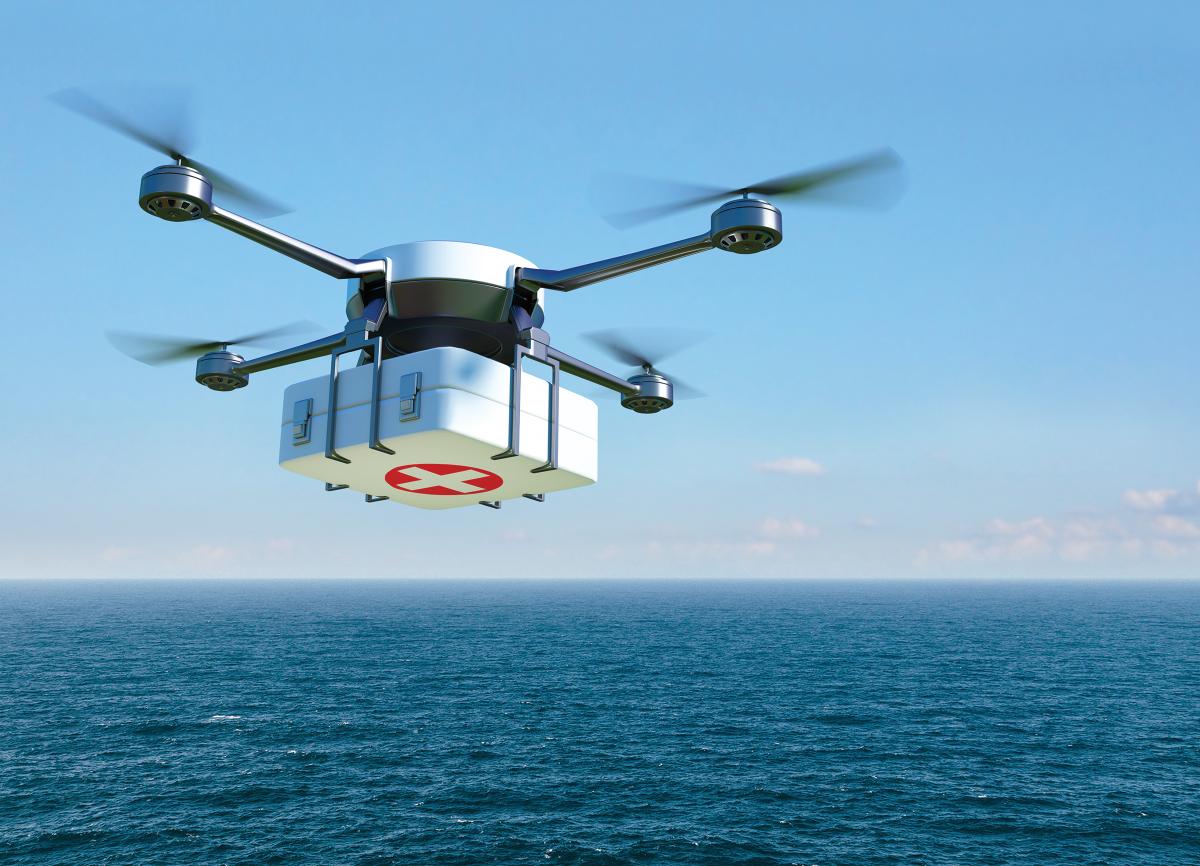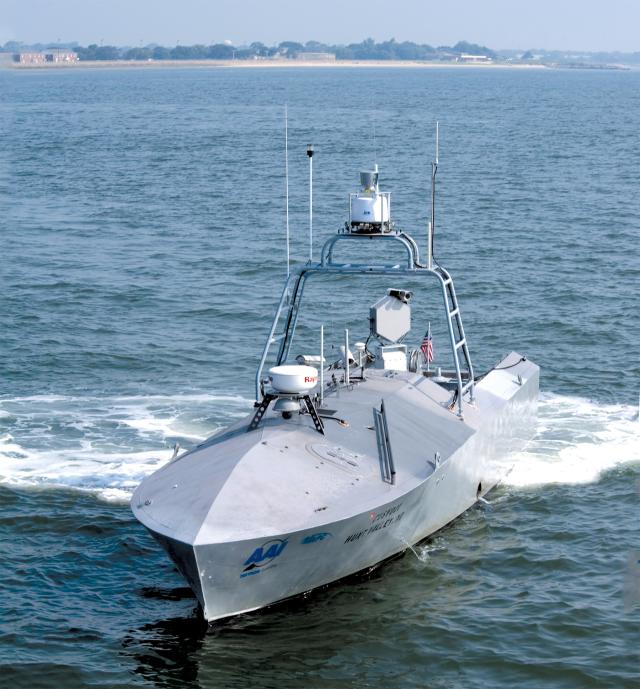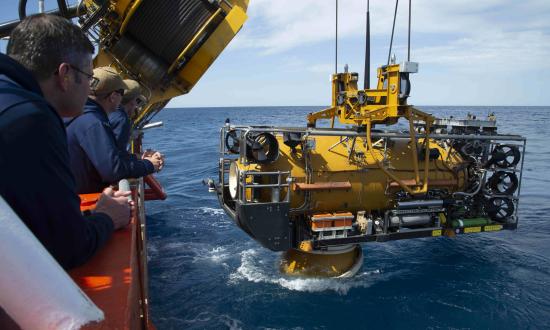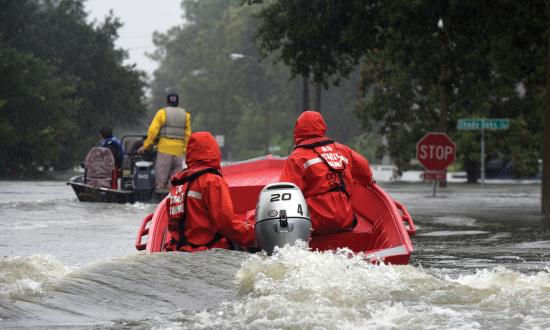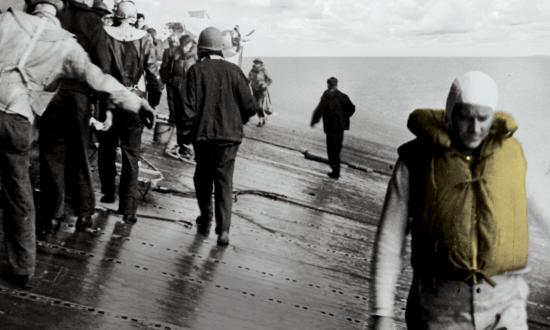Salvos of torpedoes came in from the enemy position, hitting and critically wounding the ship. Within 12 minutes, the ship had sunk, and the nearly 900 crew members who were able to abandon ship were in the water, struggling to survive, hoping for rescue. Many are familiar with the story of the heavy cruiser USS Indianapolis (CA-35), in part because of her crew’s heroism and strength, but also because of the tragedy that was their rescue. The cruiser carried a crew of 1,196 sailors, of whom only 317 survived until rescued.1
While the reasons for the disaster are numerous, the critical question it raises for today is, can the Navy quickly rescue a large, dispersed group of sailors floating aimlessly in the sea? What if the casualty were an aircraft carrier with a crew of more than 4,500 sailors?
Drones are becoming more common in the military, but one area that has been overlooked, in which they have the potential to add significant new capability and capacity, is medical and emergency response.
Sailors Matter Most
In modern naval warfare, crews are smaller and more technologically educated and tactics are far more complex than in the past.For this reason, service members are both a critical requirement and a critical vulnerability; thus, extraordinary effort must be made to preserve ships’ medical readiness and enhance emergency response to keep service members fighting.
Responses to medical threats to sailors at sea have not changed notably in decades. Big-deck ships, such as aircraft carriers, have a physician in their complement who also serves as the subject-matter expert for the battle group. Smaller ships such as cruisers, destroyers, and mine-sweepers may be supported by a single corpsman and have limited ability to provide care. Should an emergency on a small ship require advanced care, limited resources and delays because of air evacuation or the need to secure the small ship to a ship with advanced medical assets may result in the worsening of injuries or even death.
Considering the dispersed nature of naval fleets and their limited access to medical services, drones—both unmanned aerial vehicles (UAVs) and unmanned surface vehicles (USVs)—could provide a new and radically different approach to delivering medical care and emergency response in the fleet.
Delivery of Supplies and Services
Currently, if a sailor on board a small ship develops a concerning infection, the corpsman will consult the battle group physician, which may lead to evacuation of the patient by air or sea to the main ship, disrupting operations. But it does not have to be this way.
Imagine the same patient, but instead of an evacuation, a medical UAV is launched from the big deck to the small ship. The corpsman draws a blood sample, places it on the drone, and the drone delivers it back to the main ship, where it is analyzed and a diagnosis and assessment of severity is made. This scenario is not far-fetched, and it is likely the first and easiest application of medical UAVs in the fleet. Studies have demonstrated that blood and microbiological samples can be transported long distances without being compromised.2 In addition, telecommunications-equipped drones can be used to connect physicians to patients and allow interviews, focused examinations, telementoring of corpsmen, and monitoring of patient status.3
Emergency Care
Perhaps the most research on using UAVs in medicine has been on delivering emergency equipment, particularly automated electronic defibrillators (AEDs). All U.S. naval vessels are equipped with AEDs, but drones are able to quickly deliver emergency care to remote locations, as well.
In one study, drones launched from existing emergency medical service (EMS) locations were able to deliver AEDs within one minute of notification 80 percent of the time.4 Mathematical models of medical drone networks estimate that drones can reach urban targets seven minutes faster than ambulances and more than ten minutes faster in rural areas.5 In another study, GPS-equipped drones arrived a mean of 19 minutes before EMS to rural areas, and in another they flew a mean distance of nearly two miles and arrived within six minutes of notification (compared with 22 minutes by EMS vehicle).6 When launched automatically (instead of manually) after notification of an emergency, drones were able to dispatch within three seconds.7
Time is critical in responding to emergency events, and UAVs offer an opportunity to respond within critical time windows and potentially save lives.
Drones also have been studied as a means to deliver other emergency services and equipment. On land, one study used an automated GPS-guided drone to deliver emergency medical supplies such as tourniquets, wound dressings, and analgesics to very remote locations. The drone was able to autonomously travel a mean 7.6 miles in a mean time of 20.77 minutes and deliver the package to within a yard of the patient, compared to wheeled vehicle response time of 61.35 minutes and foot travel response time of 5.1 hours.8 Imagine a future in which a Marine wounded in combat pushes a GPS locator on his or her tactical vest, causing a staged UAV at the battalion aid station to launch within three seconds and deliver aid within a minute; this technology could significantly change battlefield care. At sea, this technology could be used to launch drones (autonomously or manually) from a central medical hub (likely an aircraft carrier) as emergency support to the battle group.
Search and Rescue
For search and rescue, UAVs offer not only the fast delivery of aid to those in need, but also the ability to rapidly search large and treacherous areas. In simulated mountain search-and-rescue events that paired a drone search with a snowmobile response, rescuers were able to search a median area of close to a square mile and find victims in a median time of 8.9 minutes. This compared with a median search area of approximately one-third square mile and a median time of 57.3 minutes searching on foot.9 While this example was simulated, drones have proven advantageous in real-world search-and-rescue cases.10
Applied to the Navy, the concept of search and rescue conjures images of downed pilots and sailors fallen overboard. Man-overboard events are relatively rare, but considerable efforts are made to respond. These efforts are exhausting and expensive and have changed little over time. Improvements to current search and rescue using remotely operated UAVs have been proposed, but they have not yet been introduced to the fleet.11
Finding the sailor or airman is the first critical step in a rescue, but delivering rescue services is just as essential to victim survival. Drones can launch quickly, search wide areas, and have demonstrated the ability to rapidly deliver life buoys and flotation devices in a variety of sea states, far surpassing response times using traditional methods.12 In the near future, man-overboard operations may involve staged medical UAVs with the ability to not only find sailors fast, but also immediately deliver rescue services.
In the event of a total loss of a ship and her crew stranded in the water, drones could be applied in one of several ways. They could be launched from other vessels and either be remotely directed or, more preferably, autonomously search the area for survivors. The drones would be equipped with individual or group-sized flotation devices that can be dropped as sailors are found. It is possible that swarms of drones could be launched in seconds, search hundreds of thousands of square meters, and, in many cases, identify and provide rescue equipment to survivors just minutes after they enter the water.
Using UAVs to find and provide flotation aids to large groups of sailors would be a major advance in search-and-rescue and naval mass-casualty response, but it still is incomplete. In all search-and-rescue responses, resolution comes only after other ships are able to recover the victims—something that may not be possible in the heat of battle and may not be feasible if there are thousands of stranded sailors. A potential solution is the use of USVs. Autonomous UAVs and USVs would launch simultaneously, search the area, identify and mark stranded sailors using GPS coordinates, and deliver temporary survival equipment. The sailors’ coordinates would be relayed to the surface drone, which would collect the stranded sailors—all while the ships keep fighting.
On their own, remotely operated UAVs can provide a critical advantage in response to naval catastrophes, but the technology is optimized when operated as part of a network of aerial and surface drones.
A Tactical Advantage
In combat against near-peer adversaries who have the ability to challenge sea control, the loss of ships is a real possibility, and recovery of their sailors is a necessity. Conventional methods for response may be insufficient. In the future fleet, medical drone hubs will be located within a strike group, and individual ships will be nodes on a drone network. Signals from the ships relaying man-overboard events, calls for medical support, or other emergent situations will result in the immediate autonomous deployment of medical drones. In the event a ship is sunk and her crew scattered in the ocean, autonomous UAVs and USVs will deploy to identify survivors, deliver immediate rescue equipment, and pick up and deliver survivors to safety, all while allowing the fleet to continue fighting. Adopting medical support drones is a necessary step to improve the Navy’s search-and-rescue and emergency medical response capabilities in crises and war.
1. See Sara Vladic, “Lost Survivor of the USS Indianapolis (CA-35) Found,” U.S. Naval Institute Proceedings 143, no. 9 (September 2017), and K. Phillips, “‘We knew the ship was doomed’: USS Indianapolis Survivor Recalls Four Days in Shark-filled Sea,” The Washington Post, 20 August 2017, www.washingtonpost.com/news/retropolis/wp/2017/08/20/we-knew-the-ship-was-doomed-uss-indianapolis-survivor-recalls-four-days-in-shark-filled-sea/.
2. T. K. Amukele, J. Street, K. Carroll, H. Miller, and S. X. Zhang, “Drone Transport of Microbes in Blood and Sputum Laboratory Specimens,” Journal of Clinical Microbiology 54, no. 10 (2016): 2622–25, and T. Amukele, P. M. Ness, A. A. Tobian, J. Boyd, and J. Street, “Drone Transportation of Blood Products,” Transfusion 57, no. 3 (2017): 582–88.
3. J. C. Rosser Jr., V. Vignesh, B. A. Terwilliger, and B. C. Parker, “Surgical and Medical Applications of Drones: A Comprehensive Review,” Journal of the Society of Laproscopic and Robotic Surgeons 22, no. 3 (July–September 2018), and I. Subbarao and G. P. Cooper Jr., “Drone-Based Telemedicine: A Brave But Necessary New World,” Journal of the American Osteopathic Association 115, no. 12 (December 2015): 700–1.
4. A. Pulver, R. Wei, and C. Mann, “Locating AED Enabled Medical Drones to Enhance Cardiac Arrest Response Times,” Prehospital Emergency Care Journal 20, no. 3 (May–June 2016): 378–89.
5. J. J. Boutilier et al., “Optimizing a Drone Network to Deliver Automated External Defibrillators,” Circulation 135, no. 25 (March 2017): 2454–65.
6. A. Claesson et al., “Unmanned Aerial Vehicles (Drones) in Out-of-Hospital Cardiac Arrest,” Scandinavian Journal of Trauma, Resuscitation, and Emergency Medicine 24 (October 2016), and A. Claesson et al., “Time to Delivery of an Automated External Defibrillator Using a Drone for Simulated Out-of-Hospital Cardiac Arrests vs Emergency Medical Services,” Journal of the American Medical Association 317, no. 22 (June 2017): 2332–34.
7. Claesson et al., “Unmanned Aerial Vehicles (Drones) in Out-of-Hospital Cardiac Arrest.”
8. T. Mesar, A. Lessig, and D. R. King, “Use of Drone Technology for Delivery of Medical Supplies During Prolonged Field Care,” Journal of Special Operations Medicine 18, no. 4 (Winter 2018): 34–35.
9. Y. Karaca et al., “The Potential Use of Unmanned Aircraft Systems (Drones) in Mountain Search and Rescue Operations,” American Journal of Emergency Medicine 36, no. 4 (April 2018): 583–88.
10. C. Van Tilburg, “First Report of Using Portable Unmanned Aircraft Systems (Drones) for Search and Rescue,” Wilderness and Environmental Medicine 28, no. 2 (March 2017): 116–18; and J. N. McRae, C. J. Gay, B. M. Nielsen, and A. P. Hunt, “Using an Unmanned Aircraft System (Drone) to Conduct a Complex High Altitude Search and Rescue Operation: A Case Study,” Wilderness and Environmental Medicine 30, no. 3 (September 2019): 287–90.
11. W. Olson, “Search-and-Rescue Drones Could One Day Save Overboard Sailors,” Stars and Stripes, 22 May 2017, www.stripes.com/news/search-and-rescue-drones-could-one-day-save-overboard-sailors-1.469682.
12. A. Backman et al., “Drones for Provision of Flotation Support in Simulated Drowning,” Air Medical Journal 37, no. 3 (2018): 170–73; and C. Seguin, G. Blaquiere, A. Loundou, P. Michelet, and T. Markarian, “Unmanned Aerial Vehicles (Drones) to Prevent Drowning,” Resuscitation 127 (June 2018): 63–67.



